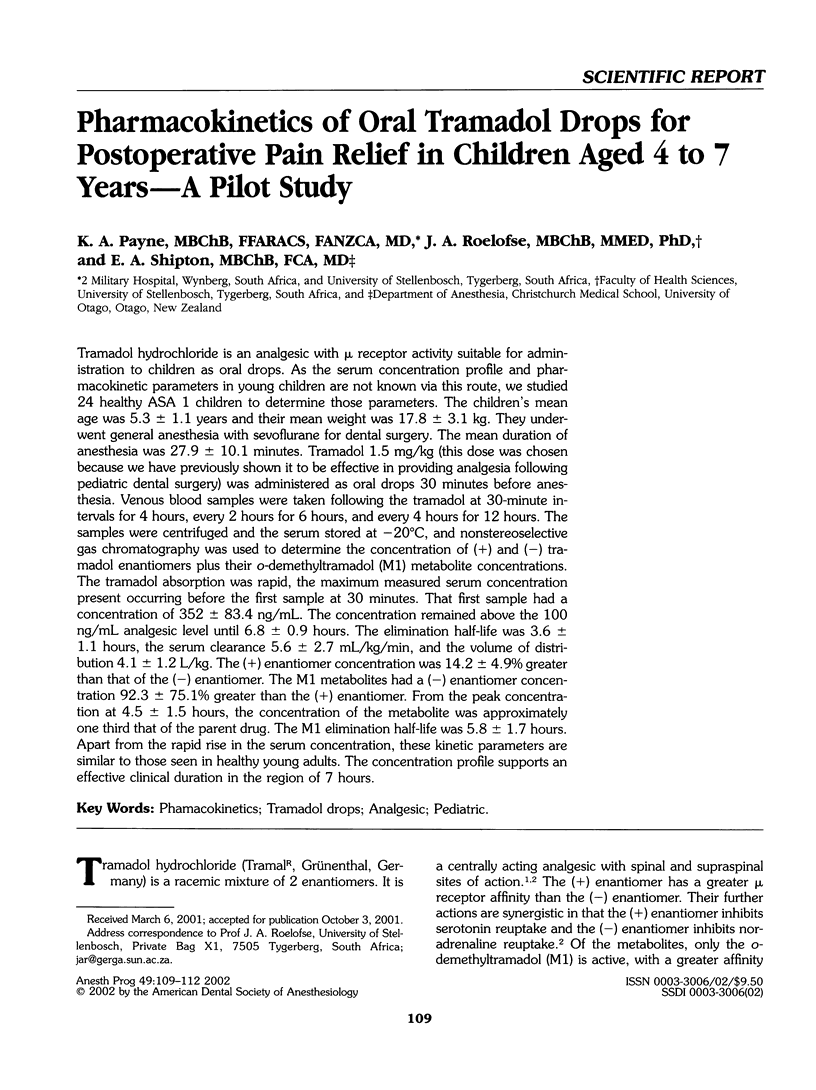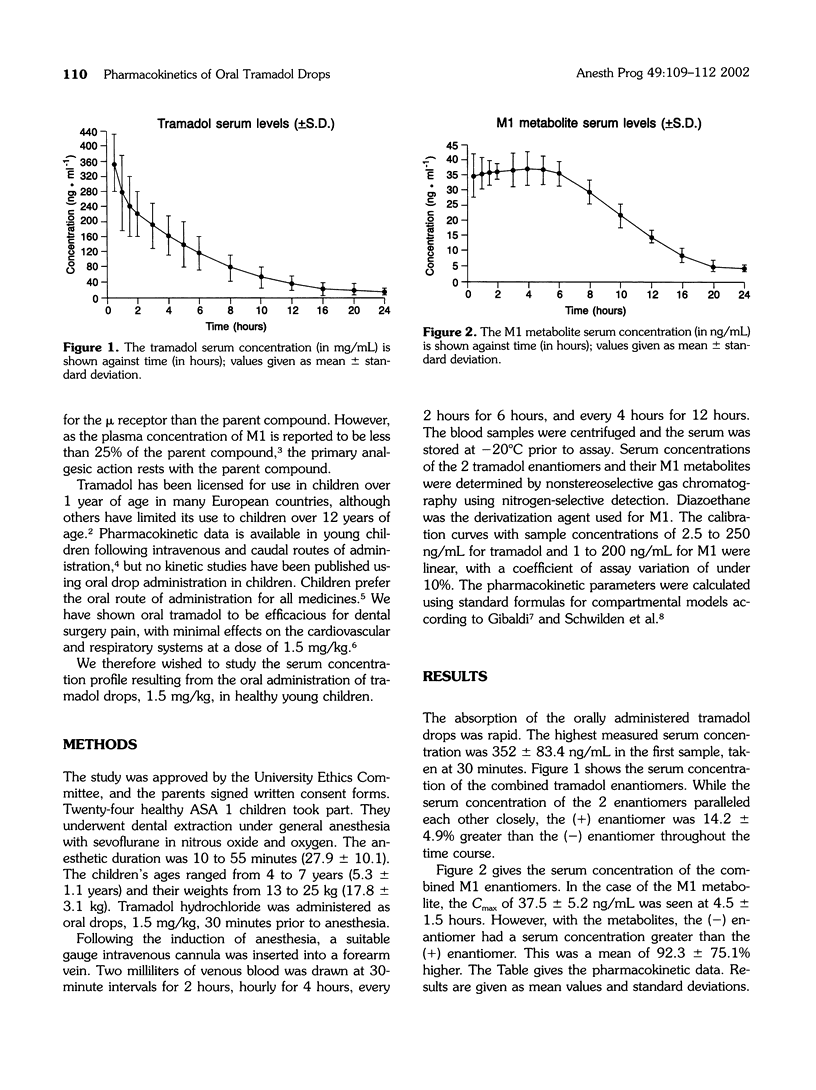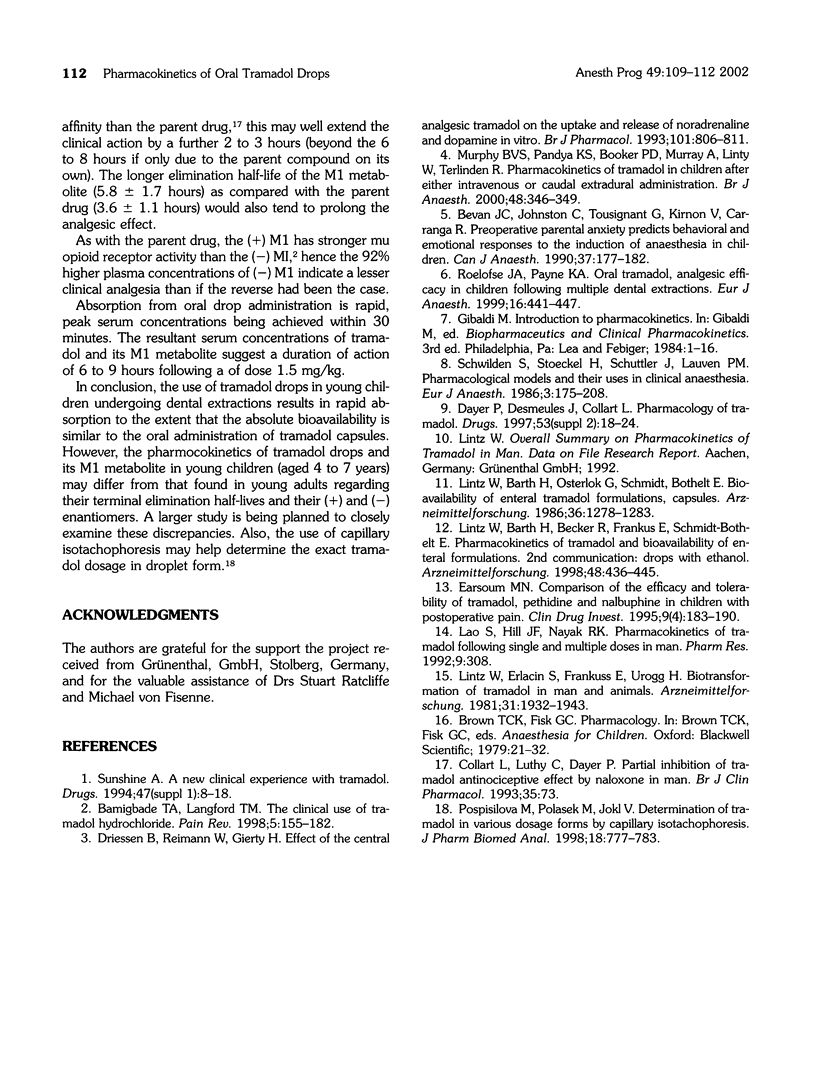Abstract
Tramadol hydrochloride is an analgesic with mu receptor activity suitable for administration to children as oral drops. As the serum concentration profile and pharmacokinetic parameters in young children are not known via this route, we studied 24 healthy ASA 1 children to determine those parameters. The children's mean age was 5.3 +/- 1.1 years and their mean weight was 17.8 +/- 3.1 kg. They underwent general anesthesia with sevoflurane for dental surgery. The mean duration of anesthesia was 27.9 +/- 10.1 minutes. Tramadol 1.5 mg/kg (this dose was chosen because we have previously shown it to be effective in providing analgesia following pediatric dental surgery) was administered as oral drops 30 minutes before anesthesia. Venous blood samples were taken following the tramadol at 30-minute intervals for 4 hours, every 2 hours for 6 hours, and every 4 hours for 12 hours. The samples were centrifuged and the serum stored at -20 degrees C, and nonstereoselective gas chromatography was used to determine the concentration of (+) and (-) tramadol enantiomers plus their o-demethyltramadol (M1) metabolite concentrations. The tramadol absorption was rapid, the maximum measured serum concentration present occurring before the first sample at 30 minutes. That first sample had a concentration of 352 +/- 83.4 ng/mL. The concentration remained above the 100 ng/mL analgesic level until 6.8 +/- 0.9 hours. The elimination half-life was 3.6 +/- 1.1 hours, the serum clearance 5.6 +/- 2.7 mL/kg/min, and the volume of distribution 4.1 +/- 1.2 L/kg. The (+) enantiomer concentration was 14.2 +/- 4.9% greater than that of the (-) enantiomer. The M1 metabolites had a (-) enantiomer concentration 92.3 +/- 75.1% greater than the (+) enantiomer. From the peak concentration at 4.5 +/- 1.5 hours, the concentration of the metabolite was approximately one third that of the parent drug. The M1 elimination half-life was 5.8 +/- 1.7 hours. Apart from the rapid rise in the serum concentration, these kinetic parameters are similar to those seen in healthy young adults. The concentration profile supports an effective clinical duration in the region of 7 hours.
Full text
PDF



Selected References
These references are in PubMed. This may not be the complete list of references from this article.
- Bevan J. C., Johnston C., Haig M. J., Tousignant G., Lucy S., Kirnon V., Assimes I. K., Carranza R. Preoperative parental anxiety predicts behavioural and emotional responses to induction of anaesthesia in children. Can J Anaesth. 1990 Mar;37(2):177–182. doi: 10.1007/BF03005466. [DOI] [PubMed] [Google Scholar]
- Dayer P., Desmeules J., Collart L. Pharmacologie du tramadol. Drugs. 1997;53 (Suppl 2):18–24. doi: 10.2165/00003495-199700532-00006. [DOI] [PubMed] [Google Scholar]
- Driessen B., Reimann W., Giertz H. Effects of the central analgesic tramadol on the uptake and release of noradrenaline and dopamine in vitro. Br J Pharmacol. 1993 Mar;108(3):806–811. doi: 10.1111/j.1476-5381.1993.tb12882.x. [DOI] [PMC free article] [PubMed] [Google Scholar]
- Lintz W., Barth H., Becker R., Frankus E., Schmidt-Böthelt E. Pharmacokinetics of tramadol and bioavailability of enteral tramadol formulations. 2nd communication: drops with ethanol. Arzneimittelforschung. 1998 May;48(5):436–445. [PubMed] [Google Scholar]
- Lintz W., Barth H., Osterloh G., Schmidt-Böthelt E. Bioavailability of enteral tramadol formulations. 1st communication: capsules. Arzneimittelforschung. 1986 Aug;36(8):1278–1283. [PubMed] [Google Scholar]
- Lintz W., Erlaçin S., Frankus E., Uragg H. Metabolismus von Tramadol bei Mensch und Tier. Arzneimittelforschung. 1981;31(11):1932–1943. [PubMed] [Google Scholar]
- Murthy B. V., Pandya K. S., Booker P. D., Murray A., Lintz W., Terlinden R. Pharmacokinetics of tramadol in children after i.v. or caudal epidural administration. Br J Anaesth. 2000 Mar;84(3):346–349. doi: 10.1093/oxfordjournals.bja.a013437. [DOI] [PubMed] [Google Scholar]
- Pospísilová M., Polásek M., Jokl V. Determination of tramadol in various dosage forms by capillary isotachophoresis. J Pharm Biomed Anal. 1998 Dec;18(4-5):777–783. doi: 10.1016/s0731-7085(98)00270-2. [DOI] [PubMed] [Google Scholar]
- Roelofse J. A., Payne K. A. Oral tramadol: analgesic efficacy in children following multiple dental extractions. Eur J Anaesthesiol. 1999 Jul;16(7):441–447. doi: 10.1046/j.1365-2346.1999.00505.x. [DOI] [PubMed] [Google Scholar]
- Schwilden H., Stoeckel H., Schüttler J., Lauven P. M. Pharmacological models and their use in clinical anaesthesia. Eur J Anaesthesiol. 1986 May;3(3):175–208. [PubMed] [Google Scholar]
- Sunshine A. New clinical experience with tramadol. Drugs. 1994;47 (Suppl 1):8–18. doi: 10.2165/00003495-199400471-00004. [DOI] [PubMed] [Google Scholar]


